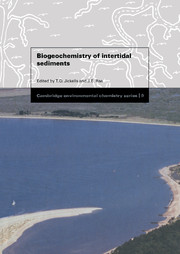Book contents
- Frontmatter
- Contents
- List of contributors
- Preface
- 1 Biogeochemistry of intertidal sediments
- 2 Trace metals in deposited intertidal sediments
- 3 Modelling adsorption and desorption processes in estuaries
- 4 A critical appraisal of the methodology used in studies of material flux between saltmarshes and coastal waters
- 5 Nutrient recycling in intertidal sediments
- 6 An overview of carbon and sulphur cycling in marine sediments
- 7 Microbial activity and diagenesis in saltmarsh sediments, North Norfolk, England
- 8 The behaviour of radionuclides in the coastal and estuarine environments of the Irish Sea
- 9 The sorption of hydrophobic pyrethroid insecticides to estuarine particles: a compilation of recent research
- Index
6 - An overview of carbon and sulphur cycling in marine sediments
Published online by Cambridge University Press: 23 September 2009
- Frontmatter
- Contents
- List of contributors
- Preface
- 1 Biogeochemistry of intertidal sediments
- 2 Trace metals in deposited intertidal sediments
- 3 Modelling adsorption and desorption processes in estuaries
- 4 A critical appraisal of the methodology used in studies of material flux between saltmarshes and coastal waters
- 5 Nutrient recycling in intertidal sediments
- 6 An overview of carbon and sulphur cycling in marine sediments
- 7 Microbial activity and diagenesis in saltmarsh sediments, North Norfolk, England
- 8 The behaviour of radionuclides in the coastal and estuarine environments of the Irish Sea
- 9 The sorption of hydrophobic pyrethroid insecticides to estuarine particles: a compilation of recent research
- Index
Summary
Introduction
In most marine-type sediments (including intertidal ones) organic carbon is the only reducing agent to enter a sediment column. The remainder of the sediment load arrives in its oxidised form, and, with the exception of straightforward compaction, early diagenesis (i.e. the process of change during burial) results directly or indirectly from the flow of electrons. The initial source of the electrons (organic matter) is sequentially oxidised in microbially mediated reactions, using a range of available oxidising agents, and results in some degree of vertical zonation in sediment chemistry (Richards et al., 1965; Froelich et al., 1979). This is because microbial communities outcompete each other for organic carbon (Stumm & Morgan, 1970; Claypool & Kaplan, 1974). However, the resolution of these sediment horizons is likely to be poor because:
(a) although the most important substrate shared by each community is organic carbon, it has been suggested that different communities metabolise different fractions of it, each with a first order rate constant (Berner, 1977). This would produce overlapping or coexistence of zones, unless the competition between communities was for another shared substrate (e.g. nitrate).
(b) the ‘dead cat in the mud’ effect (Coleman, 1985), where the substrates for microbial metabolism do not enter the system as disseminated and reactive particles to give a homogeneous reaction mixture, but rather as poorly sorted, highly concentrated sources of metabolites that may survive beyond zones where they would have been exhausted in a simple layered model. For solid substrates such as organic carbon, iron oxides and manganese oxyhydroxides, this may be an important control on their rate of supply to the reaction.
[…]
- Type
- Chapter
- Information
- Biogeochemistry of Intertidal Sediments , pp. 99 - 118Publisher: Cambridge University PressPrint publication year: 1997
- 4
- Cited by

